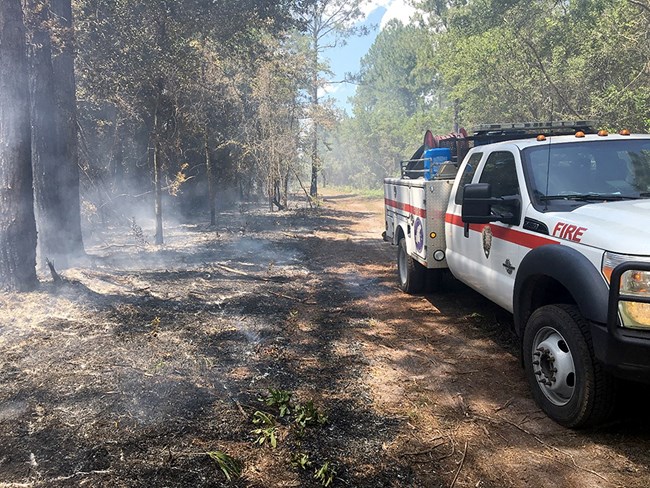Last updated: December 20, 2021
Article
Effectiveness of Fuels Treatments Yields Success at Timucuan National Preserve.

NPS
In FY’21, Timucuan National Preserve (TIMU) had success when a wildfire burned up to a preexisting fuels treatment, reducing impacts from suppression activities and reducing the need for suppression repair. A passing afternoon thunderstorm in June 2021 ignited the Red Trail fire at TIMU. The fire was contained on two sides by a fuels treatment that had been put in place by the Atlantic Zone Fire Management Office (ATLZ), leading to little need for suppression actions by firefighting resources.
Two days after the Red Trail Fire had been discovered, the Sohm fire, another lightning-caused fire that had been smoldering undetected for a couple days, became visible. Just north of where the fire started, a fuels treatment aided in a faster response by interagency personnel.
These successes would not have been possible without work that took place in 2019. That year, the Yellow Bluff Fire ignited in TIMU. The 600+ acre fire closed I-95 for 19 hours during Memorial Day weekend. The fire was a wakeup call for the park which began to put mechanical treatments in place to break up the continuity of fuels, allow for fire management options, and allow better access throughout the park. In 2020, treatments were put in areas of the Yellow Bluff fire scar and beyond. These first introductory fuels treatments were meant to primarily create access into areas not previously accessible along old roadbeds. Along with creating access, a buffer was created along these roads to give the option to burnout along them or to potentially hold fire along the edge of these treatments. In June 2021, these fuels treatments were put to the test with the Red Trail and Sohm fires. With the use of the fuels treatments, fire personnel were able to cut their response times in half and gain access using Type 6 wildland fire engines.
